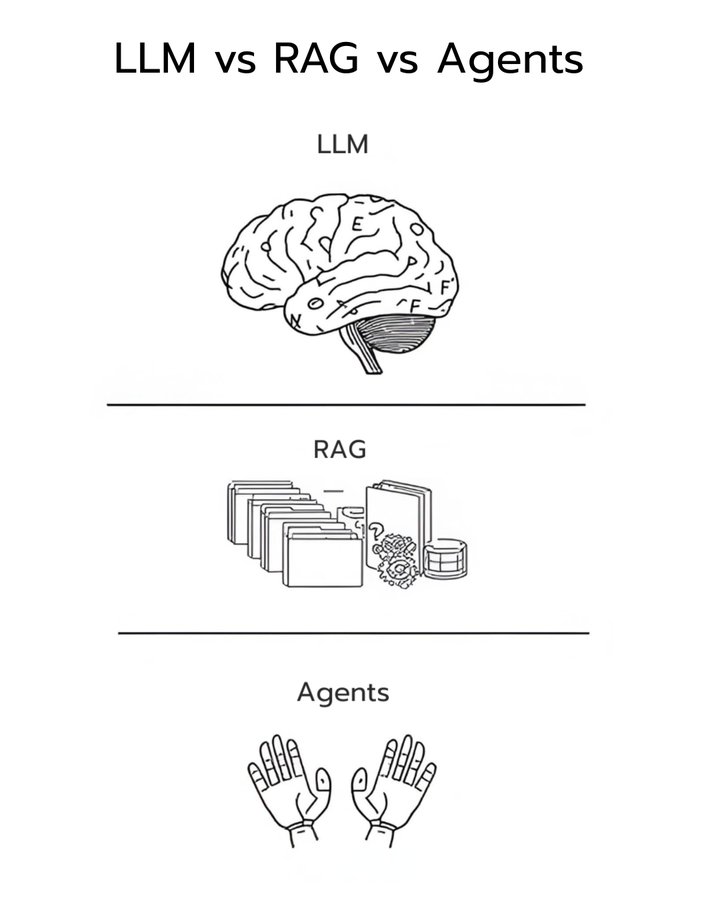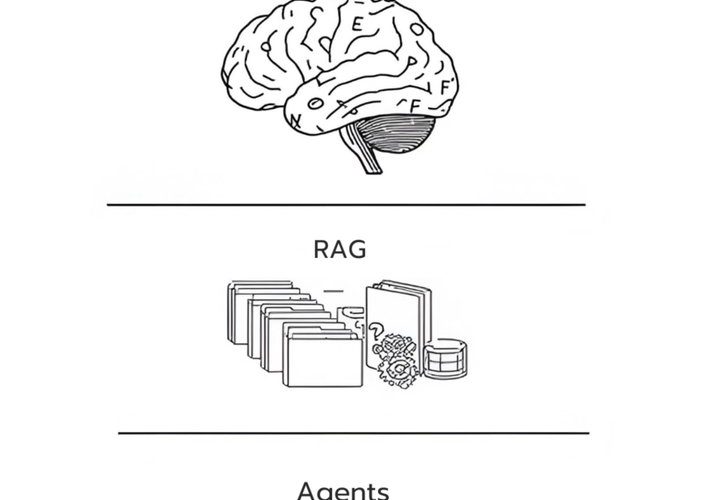After months of hands-on experience building production-grade AI systems, I’ve come to an important realization: the industry often misunderstands the relationship between LLMs, RAG, and AI Agents. These aren’t competing technologies—they’re complementary layers that form a complete intelligence architecture. Let me break down what I’ve learned.
Layer 1: The LLM as the Cognitive Engine (BRAIN)
At the foundation sits the Large Language Model—the system’s intelligence core. Think of it as the brain that powers everything else. Modern LLMs like GPT-4, Claude, or Llama possess remarkable capabilities: they understand nuanced language, generate coherent text, explain complex concepts, and synthesize information across domains with unprecedented sophistication.
But here’s the critical limitation: LLMs are temporally locked. They’re trained on data up to a specific cutoff date, and after that point, they know nothing. Their knowledge fossilizes at training time. If you ask GPT-4 about events from last week, it can’t actually know—it might hallucinate a plausible-sounding answer, but it’s essentially guessing based on patterns rather than facts. The LLM can reason brilliantly, but it’s reasoning in a vacuum, disconnected from current reality and your specific operational context.
This temporal blindness is a fundamental constraint of how LLMs work. Retraining them on fresh data is prohibitively expensive, time-consuming, and impractical for most organizations. You can’t just update an LLM every time your company launches a new product or a regulation changes.
Layer 2: RAG as the Knowledge Bridge (MEMORY)
This is where Retrieval-Augmented Generation enters the picture—and it’s a game-changer. RAG solves the knowledge gap by acting as the system’s dynamic memory layer.
Instead of trying to cram all possible information into the model during training, RAG retrieves relevant, up-to-date information on-demand and injects it into the LLM’s context window. When a user asks a question, the RAG system searches through your proprietary databases, document repositories, real-time APIs, or even the live web to find pertinent information. It then packages that retrieved knowledge and presents it to the LLM alongside the original query.
Now the LLM isn’t reasoning in a vacuum—it’s reasoning over actual, current, verifiable facts. This transforms the system from a sophisticated guesser into a grounded information processor.
The advantages are substantial:
- Currency: Your AI stays current without expensive retraining. Update your knowledge base and the system immediately knows about it.
- Accuracy: The model grounds its responses in real documents rather than probabilistic patterns, dramatically reducing hallucinations.
- Traceability: You can trace every claim back to its source document. This is crucial for enterprise applications where accountability matters.
- Specialization: You can make a general LLM an expert in your domain by connecting it to your specific knowledge repositories.
- Privacy: Sensitive data stays in your secure databases rather than being baked into a model.
RAG is the bridge between frozen intelligence and living knowledge. It gives the brain access to memory.
Layer 3: AI Agents as the Autonomous Execution Layer (DECISION MAKER)
But even an LLM with perfect, current knowledge is still fundamentally reactive—it waits for queries and responds. This is where AI Agents complete the stack by adding the capability for autonomous action.
An agent is a control loop wrapped around the LLM and RAG system that enables goal-directed behavior. Rather than simply answering questions, agents:
- Perceive: They understand objectives and current state
- Plan: They break down goals into actionable steps
- Execute: They take actions using tools, APIs, and interfaces
- Reflect: They evaluate outcomes and adjust their approach
This creates systems that don’t just think and remember—they act. An agent doesn’t just tell you how to research a market opportunity; it actually conducts the research, synthesizes findings into a report, sends it to stakeholders, monitors feedback, and iterates based on responses.
Think of practical applications:
- A customer support agent that retrieves relevant documentation, drafts responses, escalates complex issues, and follows up autonomously
- A research agent that gathers information from multiple sources, cross-references findings, identifies gaps, and produces comprehensive analyses
- A workflow automation agent that monitors systems, detects anomalies, investigates root causes, and implements fixes
Agents transform AI from a sophisticated assistant into an autonomous collaborator that operates with genuine independence while still being transparent and controllable.
Architecting Production AI: Integrating All Three Layers
The critical insight is that production-grade AI systems require thoughtful integration of all three components. Here’s how to think about deploying each layer:
Deploy LLMs alone when:
- The task is purely creative or analytical (writing, brainstorming, code generation)
- You need explanation or summarization of provided content
- General knowledge and reasoning are sufficient
- Real-time accuracy isn’t mission-critical
Add RAG when:
- Precision and factual accuracy are non-negotiable
- You need to reference specific internal documentation or specialized knowledge
- Information changes frequently and needs to stay current
- You require citation and traceability for compliance or trust
- Domain expertise beyond general knowledge is essential
Deploy full Agents when:
- You need end-to-end task completion, not just answers
- The workflow involves multiple steps, decisions, and tool use
- You want autonomous operation with minimal human intervention
- The system needs to adapt its approach based on intermediate results
- You’re automating complex processes that traditionally required human judgment
The Path Forward
Most AI implementations I’ve encountered stop at layer one—they’re essentially sophisticated chatbots powered by an LLM. They can impress in demos but fail in production because they lack grounding and agency.
The future of practical AI isn’t about choosing between these approaches or waiting for one technology to make the others obsolete. It’s about understanding their complementary roles and architecting them into cohesive systems.
LLMs provide the intelligence. They’re the reasoning engine that can understand, analyze, and generate.
RAG provides the knowledge. It connects that intelligence to reality—to your data, your context, your current state.
Agents provide the autonomy. They close the loop, turning intelligence and knowledge into action and results.
When you architect all three layers together thoughtfully, you move beyond AI experiments into systems that genuinely transform how work gets done. That’s where the real value lies.
LLMs think.
RAG remembers.
Agents act.
That’s the real intelligence stack.

